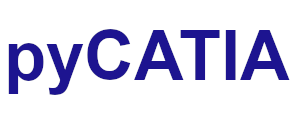pycatia.part_interfaces.revolution¶
Module initially auto generated using V5Automation files from CATIA V5 R28 on 2020-06-11 12:40:47.360445
Warning
The notes denoted “CAA V5 Visual Basic Help” are to be used as reference only. They are there as a guide as to how the visual basic / catscript functions work and thus help debugging in pycatia.
- class pycatia.part_interfaces.revolution.Revolution(com_object)¶
Note
CAA V5 Visual Basic Help (2020-07-06 14:02:20.222384)
System.IUnknownSystem.IDispatchSystem.CATBaseUnknownSystem.CATBaseDispatchSystem.AnyObjectMecModInterfaces.ShapePartInterfaces.SketchBasedShapeRevolutionRepresents the revolution-based shapes.It is the base objects for shaft and grooves.See also:Shaft, Groove- property first_angle: Angle¶
Note
- CAA V5 Visual Basic Help (2020-07-06 14:02:20.222384)
- o Property FirstAngle() As Angle (Read Only)Returns the revolution first angle. This angle is computed around therevolution axis, starting from the sketch plane trace on the planeperpendicular to the revolution axis, and is counted positive clockwise whenlooking at this plane in the revolution axis direction.Example:The following example returns in firstAngle the first angle of theMyRevolution revolution object:Set firstAngle = MyRevolution.FirstAngle
- Return type:
- property is_thin: bool¶
Note
- CAA V5 Visual Basic Help (2020-07-06 14:02:20.222384)
- o Property IsThin() As booleanReturns the Revol thin flag.It returns TRUE if the Revol is a thin Revol , FALSE ifnot.Returns:oIsThin The thin flag as a booleanExample:The following example saves in thinFlag the thin flag of RevolfirstRevol, and then sets it so that it will be now thin:Set thinFlag = firstRevol.IsThinfirstRevol.IsThin = TRUE
- Return type:
bool
- property merge_end: bool¶
Note
- CAA V5 Visual Basic Help (2020-07-06 14:02:20.222384)
- o Property MergeEnd() As booleanReturns the Revol merge end flag (for thin Revol only).It returns TRUE if merge ends is required , FALSE if not.Returns:oIsMergeEnd The merge end flag as a booleanExample:The following example saves in MergeEndFlag the merge end flag ofRevol firstRevol, and then sets it so that merge end will be required:Set MergeEndFlag = firstRevol.IsMergeEndfirstRevol.IsMergeEnd = TRUE
- Return type:
bool
- property neutral_fiber: bool¶
Note
- CAA V5 Visual Basic Help (2020-07-06 14:02:20.222384)
- o Property NeutralFiber() As booleanReturns the Revol neutral fiber flag (for thin Revolonly).It returns TRUE if the Revol is a neutral fiber Revol , FALSE ifnot.Returns:oIsNeutralFiber The neutral fiber flag as a booleanExample:The following example saves in NeutralFiberFlag the neutral fiberflag of Revol firstRevol, and then sets it so that it will be now neutral fiber:Set NeutralFiberFlag = firstRevol.IsNeutralFiberfirstRevol.IsNeutralFiber = TRUE
- Return type:
bool
- property revolute_axis: Reference¶
Note
- CAA V5 Visual Basic Help (2020-07-06 14:02:20.222384)
- o Property RevoluteAxis() As ReferenceReturns or sets the rotation axis for Revol.To set the property, you can use one of the following Boundary objects:RectilinearTriDimFeatEdge, RectilinearBiDimFeatEdge orRectilinearMonoDimFeatEdge.Example: This example retrieves in RevoluteAxis the rotation axis for the Rotate axis of theRevol feature Dim RevoluteAxis As Reference Set RevoluteAxis = Rotate.Axis
- Return type:
- property second_angle: Angle¶
Note
- CAA V5 Visual Basic Help (2020-07-06 14:02:20.222384)
- o Property SecondAngle() As Angle (Read Only)Returns the revolution second angle. This angle is computed around therevolution axis, starting from the sketch plane trace on the planeperpendicular to the revolution axis, and is counted positive counterclockwisewhen looking at this plane in the revolution axis direction. Its default valueis 0.Example:The following example returns in secondAngle the second angle of theMyRevolution revolution object:Set secondAngle = MyRevolution.SecondAngle
- Return type:
